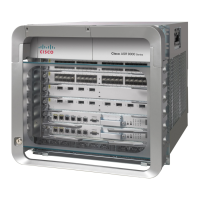A-155
Cisco ASR 9000 Series Aggregation Services Router Getting Started Guide
OL-28417-02
Chapter Understanding Regular Expressions, Special Characters, and Patterns
Multiple-Character Patterns
Multiple-Character Patterns
Multiple-character regular expressions can be formed by joining letters, digits, and keyboard characters
that do not have a special meaning. With multiple-character patterns, order is important. The regular
expression a4% matches the character a followed by a 4 followed by a %. If the string does not have
a4%, in that order, pattern matching fails.
The multiple-character regular expression a. uses the special meaning of the period character to match
the letter a followed by any single character. With this example, the strings ab, a!, and a2 are all valid
matches for the regular expression.
Put a backslash before the keyboard characters that have special meaning to indicate that the character
should be interpreted literally. Remove the special meaning of the period character by putting a
backslash in front of it. For example, when the expression a\\. is used in the command syntax, only the
string a. is matched.
A multiple-character regular expression containing all letters, all digits, all keyboard characters, or a
combination of letters, digits, and other keyboard characters is a valid regular expression. For example:
telebit 3107 v32bis.
Complex Regular Expressions Using Multipliers
Multipliers can be used to create more complex regular expressions that instruct Cisco IOS XR software
to match multiple occurrences of a specified regular expression. Table 38 lists the special characters that
specify “multiples” of a regular expression.
The following example matches any number of occurrences of the letter a, including none:
a*
The following pattern requires that at least one occurrence of the letter a in the string be matched:
a+
The following pattern matches the string bb or bab:
ba?b
The following string matches any number of asterisks (*):
\\**
To use multipliers with multiple-character patterns, enclose the pattern in parentheses. In the following
example, the pattern matches any number of the multiple-character string ab:
(ab)*
As a more complex example, the following pattern matches one or more instances of alphanumeric pairs:
([A-Za-z][0-9])+
Ta b l e 38 Special Characters Used as Multipliers
Character Description
* Matches 0 or more single-character or multiple-character patterns.
+ Matches 1 or more single-character or multiple-character patterns.
? Matches 0 or 1 occurrences of a single-character or multiple-character pattern.

